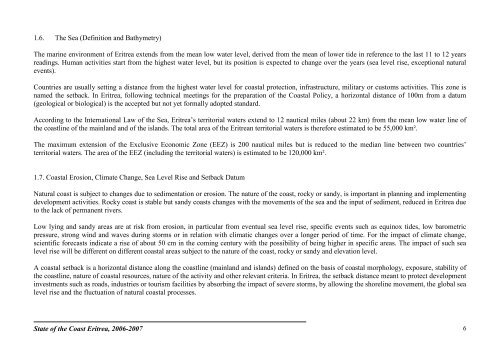Eritrea's Coastal Marine and Island Biodiversity Conservation Project
Eritrea's Coastal Marine and Island Biodiversity Conservation Project
Eritrea's Coastal Marine and Island Biodiversity Conservation Project
You also want an ePaper? Increase the reach of your titles
YUMPU automatically turns print PDFs into web optimized ePapers that Google loves.
1.6. The Sea (Definition <strong>and</strong> Bathymetry)<br />
The marine environment of Eritrea extends from the mean low water level, derived from the mean of lower tide in reference to the last 11 to 12 years<br />
readings. Human activities start from the highest water level, but its position is expected to change over the years (sea level rise, exceptional natural<br />
events).<br />
Countries are usually setting a distance from the highest water level for coastal protection, infrastructure, military or customs activities. This zone is<br />
named the setback. In Eritrea, following technical meetings for the preparation of the <strong>Coastal</strong> Policy, a horizontal distance of 100m from a datum<br />
(geological or biological) is the accepted but not yet formally adopted st<strong>and</strong>ard.<br />
According to the International Law of the Sea, Eritrea’s territorial waters extend to 12 nautical miles (about 22 km) from the mean low water line of<br />
the coastline of the mainl<strong>and</strong> <strong>and</strong> of the isl<strong>and</strong>s. The total area of the Eritrean territorial waters is therefore estimated to be 55,000 km².<br />
The maximum extension of the Exclusive Economic Zone (EEZ) is 200 nautical miles but is reduced to the median line between two countries’<br />
territorial waters. The area of the EEZ (including the territorial waters) is estimated to be 120,000 km².<br />
1.7. <strong>Coastal</strong> Erosion, Climate Change, Sea Level Rise <strong>and</strong> Setback Datum<br />
Natural coast is subject to changes due to sedimentation or erosion. The nature of the coast, rocky or s<strong>and</strong>y, is important in planning <strong>and</strong> implementing<br />
development activities. Rocky coast is stable but s<strong>and</strong>y coasts changes with the movements of the sea <strong>and</strong> the input of sediment, reduced in Eritrea due<br />
to the lack of permanent rivers.<br />
Low lying <strong>and</strong> s<strong>and</strong>y areas are at risk from erosion, in particular from eventual sea level rise, specific events such as equinox tides, low barometric<br />
pressure, strong wind <strong>and</strong> waves during storms or in relation with climatic changes over a longer period of time. For the impact of climate change,<br />
scientific forecasts indicate a rise of about 50 cm in the coming century with the possibility of being higher in specific areas. The impact of such sea<br />
level rise will be different on different coastal areas subject to the nature of the coast, rocky or s<strong>and</strong>y <strong>and</strong> elevation level.<br />
A coastal setback is a horizontal distance along the coastline (mainl<strong>and</strong> <strong>and</strong> isl<strong>and</strong>s) defined on the basis of coastal morphology, exposure, stability of<br />
the coastline, nature of coastal resources, nature of the activity <strong>and</strong> other relevant criteria. In Eritrea, the setback distance meant to protect development<br />
investments such as roads, industries or tourism facilities by absorbing the impact of severe storms, by allowing the shoreline movement, the global sea<br />
level rise <strong>and</strong> the fluctuation of natural coastal processes.<br />
State of the Coast Eritrea, 2006-2007 6


